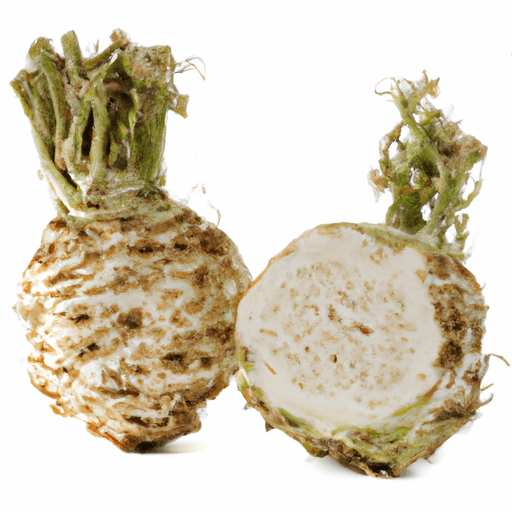Exploring the Versatility of Celery Root in Cooking
Celery root, also known as celeriac, is an underrated vegetable that often gets overlooked in the culinary world. With its knobby exterior and unique flavor profile, this humble root vegetable has a lot to offer in terms of taste, nutrition, and culinary possibilities. In this blog post, we will delve into the world of celery root and discover why it deserves a place in your kitchen.
Taste and Texture
Celery root boasts a distinct flavor that is a delightful blend of mild celery and subtle nuttiness. It offers a refreshing and slightly tangy taste with earthy undertones. The texture is dense and firm, similar to that of a potato, making it a versatile ingredient that can be prepared in various ways.
Common Uses in Cooking
One of the notable features of celery root is its ability to adapt to different cooking methods. Here are some common ways this vegetable can be used in the culinary world:
1. Soups and Stews
Celery root’s unique flavor lends itself perfectly to soups and stews. When cooked and pureed, it adds a velvety texture and an earthy taste that complements the other ingredients. Consider adding celery root to your next pot of vegetable soup or beef stew for a delightful twist.
2. Mashed or Roasted
Similar to potatoes, celery root can be mashed or roasted. When mashed, it becomes creamy and smooth, making for a delectable side dish. Alternatively, roasting celery root brings out its natural sweetness and creates a caramelized exterior, resulting in a heavenly blend of flavors.
3. Salads and Slaws
Thinly sliced or grated celery root adds a wonderful crunch and mild celery flavor to salads and slaws. Its ability to absorb dressings makes it an ideal candidate for marinated salads, allowing the flavors to infuse and intensify.
4. French Fries or Chips
Surprise your taste buds with celery root fries! Cut celery root into thin strips, toss in olive oil, and then bake or fry until golden and crispy. The result is a healthier alternative to traditional fries, packed with unique flavors.
Nutritional Value
Apart from being a versatile and flavorful ingredient, celery root also offers numerous nutritional benefits. Rich in dietary fiber, vitamin C, phosphorus, and potassium, it contributes to a healthy diet and overall well-being. Additionally, it is low in calories and carbohydrates, making it a great choice for those watching their waistline.
Interesting History and Facts
Celery root has a rich history, dating back to ancient Mediterranean civilizations. It was widely used as a medicinal plant and believed to have diuretic and digestive properties. In modern times, it gained popularity in French cuisine, particularly in classic dishes like céleri rémoulade.
Did you know that celery root is also an excellent source of folate? Folate is a vital nutrient required for the production of red blood cells and proper fetal development during pregnancy. Including celery root in your diet can help ensure adequate folate intake.
Don’t underestimate the versatility of celery root in your culinary adventures. Whether you’re looking to add a new dimension to soups, create unique side dishes, or explore French-inspired recipes, celery root is your answer. Its refreshing flavor, nutritional benefits, and intriguing history make it a vegetable worth exploring. So, the next time you stroll through the produce aisle, consider grabbing a celery root and unlocking its culinary potential!
Sure! Here are some interesting facts about celery root:
Origin and Common Uses:
- Celery root, also known as celeriac, is a root vegetable that belongs to the same family as celery.
- It is believed to have originated in the Mediterranean region and has been cultivated for its culinary uses for centuries.
- While celery stalks are often used in salads or as a flavoring ingredient, celery root is more commonly used as a cooked vegetable.
- It has a distinct flavor, often described as a combination of celery and parsley, with a slightly nutty undertone.
- Celery root is used in various cuisines around the world, including French, Italian, and Eastern European cuisines.
- It can be boiled, roasted, sautéed, or mashed, and is commonly used in soups, stews, gratins, and purees.
Nutritional Benefits:
- Celery root is a low-calorie vegetable, making it a great option for those looking to maintain or lose weight.
- It is a good source of dietary fiber, which can help promote healthy digestion.
- It contains several vitamins and minerals, including vitamin K, vitamin C, potassium, and phosphorus.
- It is also a good source of antioxidants, which can help protect the body against free radicals.
- Celery root may have anti-inflammatory properties and may help support heart health due to its potassium content.
Unique Properties and Historical Significance:
- Celery root has a rough, irregularly-shaped exterior with a pale, knobby appearance.
- Despite its appearance, the flesh of celery root is crisp, creamy white, and tender when cooked.
- It has a high moisture content, which gives it a refreshing and crunchy texture.
- Celery root has been used in traditional medicine for its potential diuretic and detoxifying properties.
- In some cultures, celery root has been used as an herbal remedy for various ailments, including digestive issues and rheumatism.
These are some factual details about celery root, including its origin, common uses, nutritional benefits, and unique properties.




Use the share button below if you liked it.
It makes me smile, when I see it.